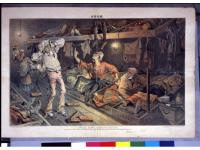This cross-curricular lesson plan explores anti-immigrant sentiment and stereotyping during the 19th century. Using the Irish as a case study, students learn about the reasons nativism has emerged in American life, and how they can apply the lessons of history to critically understand and contextualize attitudes toward immigrants today.
This lesson presents students cartoons depicting stereotypes of Irish immigrants in the late 19th century. Students will interpret the meanings of these cartoons and analyze how they both reflected and shaped the general population’s view of Irish immigrants. Then students will examine the case of the 1844 anti-Irish riots in Philadelphia. Drawing on a variety of sources and first-person accounts of the incident, students will discuss point of view in historical narrative and generate their own narrative accounts of the riots.



